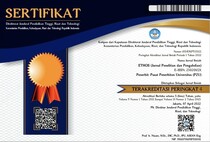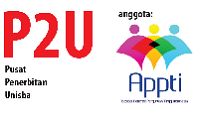Biology Lesson by Using Animation Video’s Media for Senior High School Students
Abstract
The goal of giving Biology lesson at non formal course for senior high school students is for making them prepare on the school exams, enter university and as a important knowledge for the application functional of their daily life. Although biology is one of science subjects that everyday around us and in our daily environments, the students uninterested toward this subject, and having difficulties understanding biology lesson. Meanwhile, the writer found that a few of students take biology as an unimportant lesson at many reasons, one of them is more like another science subjects.
The animation playing of videos was done at study course institute of Suhaymie Institute that located at seruni street number 51, Ketapang, Genteng, Surabaya, east Java. This activity ran at 2017/2018 academic calendar started from september 2017 to march 2018. The result showed all of students gave positive feedback 100% between 4 classes (alpha, beta, gamma, and delta) at the end of the lesson. The students became more understand about the lesson because video animation showed them audio-visually and the biological process can be seen directly.
Keywords
Full Text:
PDFReferences
Ahmed, M. A. (2008). Influence of personality factors on biology lecturers’ assessment of difficulty levels of genetics concepts in Nigerian colleges of education (Unpublished doctoral thesis). University of Ilorin, Ilorin, Nigeria.
Ahmed, M. A., & Abimbola, I. O. (2011). Influence of teaching experience and school location on biology teachers’ rating of the difficult levels of nutrition concepts in Ilorin, Nigeria. JOSTMED, 7(2), 52-61.
Nugroho, A. (2015). Pengaruh penggunaan media pembelajaran berbasis power point dengan video dan animasi terhadap motivasi belajar dan prestasi belajar pada materi perawatan unit kopling siswa kelas 2 Jurusan Teknik Kendaraan Ringan SMK Piri 1 Yogyakarta. Universitas Negeri Yogyakarta.
Leow, M. F. (2014). Interactive multimedia learning: Innovating classroom education in a Malaysian University. The Turkish Online Journal of Educational Technology, 13(2), 99–110.
Ossai-Ughbah N.B., and Ogunrombi S.A., and Ameh I.O. (2012). Motivating use of Audio-Visuals in a Nigerian Technological University Library. Journal of Educational and Social Research. 2(1), p. 217-233.
Pruneski, J., & Donovan, S. (2007). The use of animations in undergraduate biology education : Going beyond the content !, (937791), 937791.
Saragih, L. (2012). Pengaruh penggunaan video pembelajaran terhadap motivasi belajar siswa pada pembelajaran sistem injeksi bahan bakar diesel kelas XI Jurusan Teknik Kendaraan Ringan SMK Piri Yogyakarta. Universitas Negeri Yogyakarta.
Setiawan, I.G.A.N. (2008). Application of Problem Based Contextual Instruction to Increase Biology Learning Outcome of The Grade X Students in “Laboratory” Senior High School at Singaraja. Research and Development Education Journal, 2(1), p. 42-59.
Suleman, Q., Aslam, H.D., Sarwar, S., Shakir, M.M.N., Hussain, I. (2011). Effectiveness of Educational
Technology in Teaching Chemistry to Secondary School Students in Khyber Pukhtunkhwa (Pakistan). American Journal of Scientific Research. Issue 41. 2011, pp. 115-131. Euro Journals Publishing, Inc 2011.
Tekkaya, C., Ozkan, O., Sungur, S. (2001). Biology Concepts Perceived as Difficult by Turkish High School Students. Hacettepe Universitesi Egitim Fakultesi Dergisi Ed. 21, p. 145-150.
Umar, A. A. (2011). Effects of biology practical activities on students’ process skill acquisition in Minna, Niger State, Nigeria. JOSTMED, 7(2), 118–126.
DOI: https://doi.org/10.29313/ethos.v6i2.3740
Refbacks
- There are currently no refbacks.
Alamat Redaksi:
LPPM Unisba, Lantai 2, Jl. Purnawarman 63, Bandung 40116, Jawa Barat, (022) 4203368 , (022) 4264064. ethos.unisba@gmail.com / ethos@unisba.ac.id

This work is licensed under a Creative Commons Attribution-NonCommercial-ShareAlike 4.0 International License.














